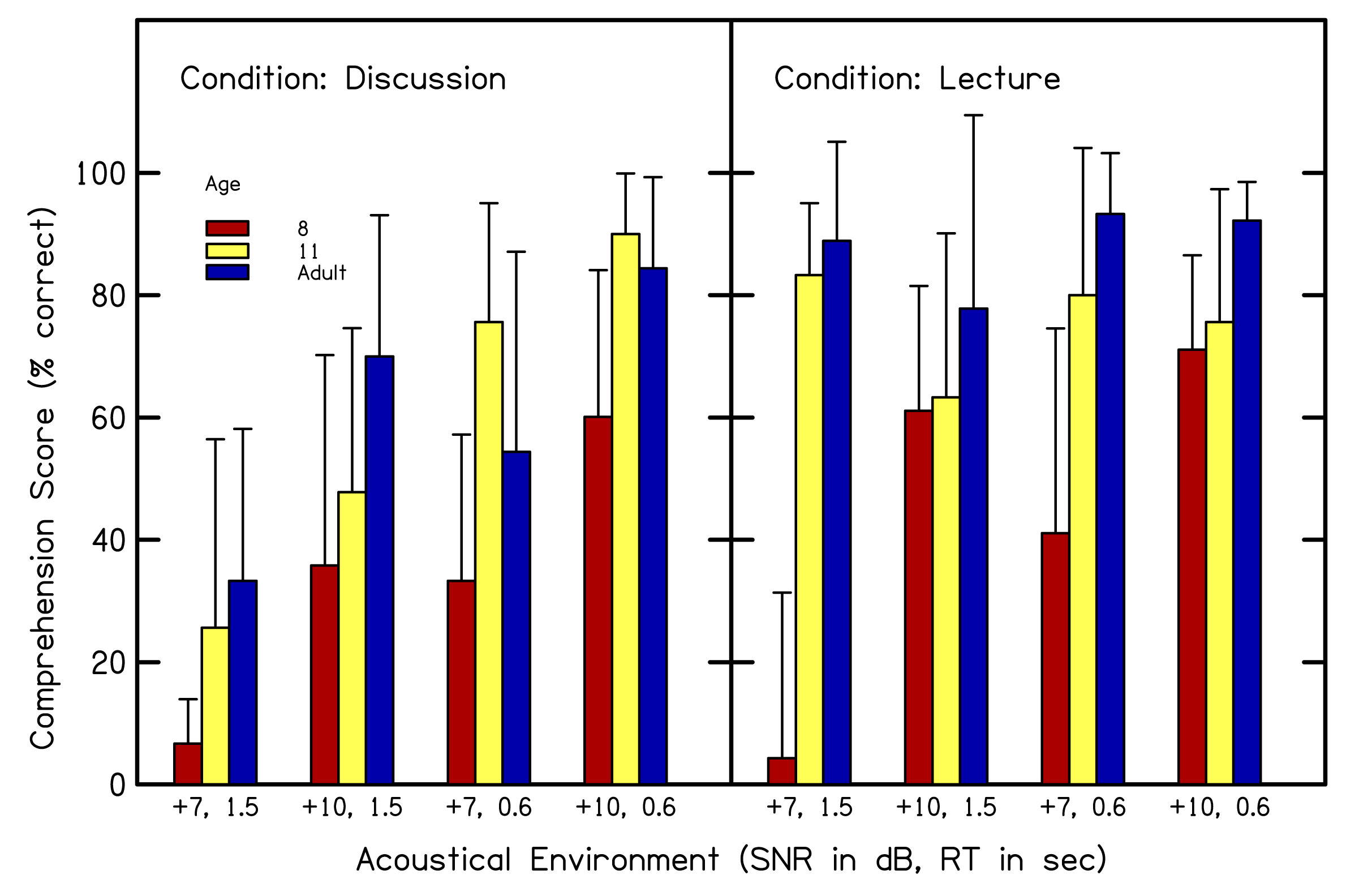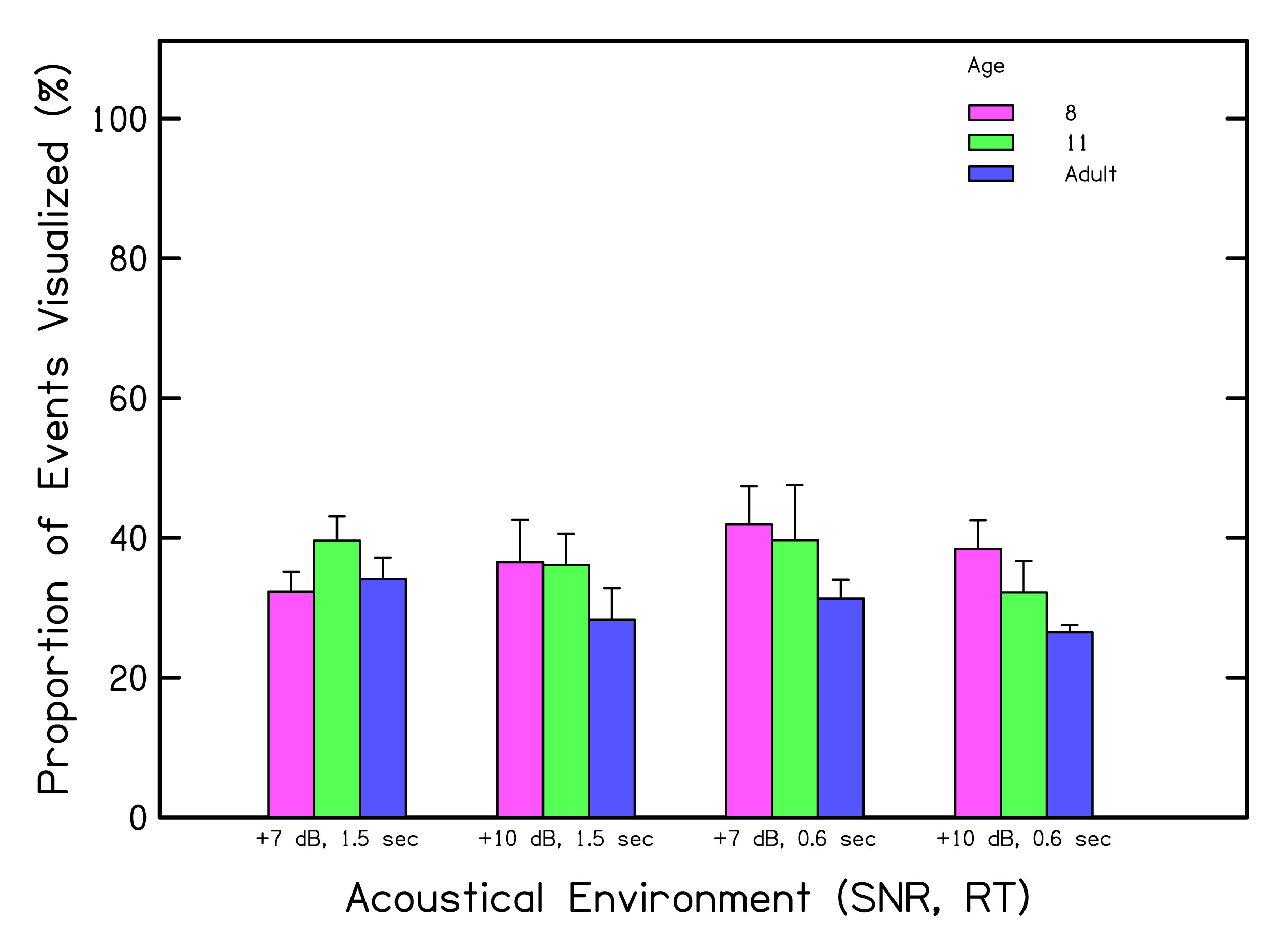
Daniel L. Valente daniel.valente@boystown.org
Dawna Lewis
Hallie Plevinsky
Elizabeth Heinrichs
Jody Spalding
John Franco
Hearing Research
Boys Town National Research Hospital
Omaha, NE 68106, USA
Popular version of paper 1pAAa9
Presented Monday Afternoon, May 23, 2011
161th ASA Meeting, Seattle, WA
Introduction
Elementary students often learn in dynamic discussions during typical classroom lessons. Many classrooms, though, have poor signal-to-noise ratios (SNR) and long reverberation times (RT). The presence of excessive noise and reverberation may increase a student’s listening effort and result in reduced performance during classroom learning.
Previous research assessing listening effort in classrooms has often been limited to a single talker located in front of the subject. In this investigation, the comprehension performance of both young and older elementary-aged (8 and 11) children, as well as adult normal-hearing listeners was studied. Subjects were presented test material in the form of a classroom learning task with a more realistic arrangement of talkers (located around the listener, as in a typical classroom).
The experiment featured several novel set-up attributes. First, a simulated classroom was created in a lab at the Boys Town Research Hospital. A 3-D rendering of the classroom setup can be seen in Figure 1. Using a combination of acoustic treatment and virtual room-model techniques, a classroom that had the same amount of background noise and sound decay (reverberation) that would be found in an ideal classroom was created. This yielded an environment in which both children and adults were able to demonstrate more than 95 percent intelligibility with sentence materials. In addition, three degraded classrooms that had (a) increased background noise, (b) longer reverberation, or(c) increased background noise and longer reverberation were simulated. By using the simulated classroom technique, we could ensure that each subject was tested in the same acoustical environment, which would have been impossible if testing had occurred in a real classroom.

Figure 1. Simulated classroom environment.
Instead of a single talker positioned in front of the subject, an array of five LCD monitors and loudspeakers reproduced the audio-visual information to a subject that sat in the middle of the classroom. Finally, since it was of interest to examine the subject’s looking behavior throughout the test, a gyroscopic head-tracker was used to record the subject’s head movements.
A total of 120 subjects were recruited for the experiment, 80 children, and 40 adults with normal hearing. Half of the subjects in each group participated in an experiment with multiple talkers while half participated in a condition where they were presented with the task on a single monitor positioned in front of the subject.
Classroom learning task:
Subjects listened to an 11-minute “readers-theater” play read by a teacher and four students reproduced over the LCD monitors. Due to the fact that the location of the active speaker shifted throughout the play, this condition is labeled “Discussion Condition”. In another condition, labeled “Lecture Condition”, the play was read by just the teacher. At the end of the play, subjects were asks a series of 18 questions to assess their comprehension of the play.
Results:
Comprehension-score results can be seen in Figure 2. In general, the younger children (8-year olds) performed more poorly than adults in both listening conditions and in all four of the simulated classroom environments. The largest difference in comprehension performance was seen in the most degraded environment (high RT and lowered SNR). Further degradation of the acoustic environment to introduce excessive noise and reverberation resulted in a drop in performance for all three groups of subjects.

Figure 2. Mean comprehension scores for the discussion and lecture conditions in the simulated classroom for 8- and 11-year old children as well as adults (Error bars denote 1 SE of the mean).
To examine listeners’ orientation to the individual talkers during the discussion condition, the proportion of events visualized (POEV) were taken by looking at the known visual angle of each of the discrete speaker’s events in time and comparing them with the gyroscopic data around the onset of the event. The number of events visualized was summed and a proportion was taken comparing the number of events that the subject visualized to the total number of events. In general, subjects localized the individual talkers less than 50% of the time. In all but the most degraded simulated classroom, children looked directly at the talkers as they spoke more often than adults (Figure 3). Due to the dynamic nature of the task and quick dialog changes between talkers, subjects were unable to look at the active talkers throughout the entire play.

Figure 3. Mean proportion of events visualized (POEV) for child and adult listeners in the discussion condition of the classroom listening task in four tested simulated classrooms (Error bars denote 1 SE of the mean).
Summary
In this experiment we found that children differed from adults in both the discussion and lecture conditions. Young children performed more poorly in conditions of excessive noise and reverberation. On average, subjects in all age groups were unable to visualize the active talker more than 50 percent of the time. In some cases, lack of visualization was more likely related to the fact that subjects didn’t need/choose to look during the course of the play. Since head movement was not controlled for during the experiment, more research is necessary to fully understand this effect.
Since younger elementary-age children are often exposed to the highest levels of background noise in their occupied classrooms, it is especially important to provide these children with learning environments that feature controlled RTs and low ambient noise levels since this age group is more sensitive to a degraded environment than their older peers or adults.
Ongoing studies are being conducted using the simulated classroom and experimental technique to examine other populations such as children with hearing loss. Conditions that include a higher amount of noise or longer reverberation are also being studied using other technologies in the environment hearing assistance technologies such as FM systems.